

Antibiotic Resistance Is Now Rife across the Globe. Dangerous antibiotic-resistant bacteria and other pathogens have now emerged in every part of the world and threaten to roll back a century of medical advances.
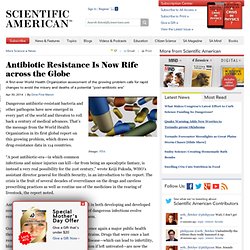
That’s the message from the World Health Organization in its first global report on this growing problem, which draws on drug-resistance data in 114 countries. “A post antibiotic-era—in which common infections and minor injuries can kill—far from being an apocalyptic fantasy, is instead a very real possibility for the 21st century,” wrote Keiji Fukuda, WHO’s assistant director general for Health Security, in an introduction to the report. Antibiotic Resistance Is Now Rife across the Globe. Dangerous antibiotic-resistant bacteria and other pathogens have now emerged in every part of the world and threaten to roll back a century of medical advances.
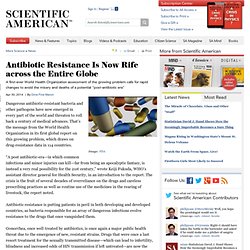
That’s the message from the World Health Organization in its first global report on this growing problem, which draws on drug-resistance data in 114 countries. “A post antibiotic-era—in which common infections and minor injuries can kill—far from being an apocalyptic fantasy, is instead a very real possibility for the 21st century,” wrote Keiji Fukuda, WHO’s assistant director general for Health Security, in an introduction to the report. End of the Antibiotic Age: You’ve Been Warned. The Microbiome, Parturition, and Timing of Birth: More questions than answers. Received 30 January 2014; received in revised form 15 March 2014; accepted 17 March 2014. published online 21 April 2014.
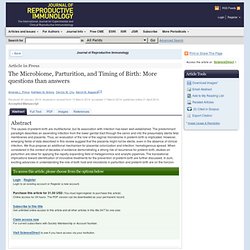
Accepted Manuscript. Heritage plaque: Our ancestors' health read from teeth - health - 21 April 2014. (Image: Michael Kirkham) Ancient microbial DNA on fossil teeth has opened a fresh window on our ancestors, revealing that civilisation has altered our mouth flora for the worse ALMOST a millennium ago, a middle-aged man was buried in a graveyard in Dalheim, Germany.

Nutritional Care of Preterm Infants - The Developing Intestinal Microbiome: Probiotics and Prebiotics. Abstract The microbes in the human intestinal tract interact with the host to form a ‘superorganism'.

The functional aspects of the host microbe interactions are being increasingly scrutinized and it is becoming evident that this interaction in early life is critical for development of the immune system and metabolic function and aberrations may result in life-long health consequences. Evidence is suggesting that such interactions occur even before birth, where the microbes may be either beneficial or harmful, and possibly even triggering preterm birth. Diet Effects in Gut Microbiome and Obesity - Chen - 2014 - Journal of Food Science. Bile acids and the gut microbiome : Current Opinion in Gastroenterology. Purpose of review: We examine the latest research on the emerging bile acid-gut microbiome axis and its role in health and disease.
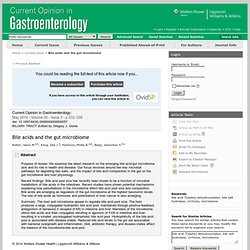
Our focus revolves around two key microbial pathways for degrading bile salts, and the impact of bile acid composition in the gut on the gut microbiome and host physiology. Recent findings: Bile acid pool size has recently been shown to be a function of microbial metabolism of bile acids in the intestines. Recent studies have shown potential mechanisms explaining how perturbations in the microbiome affect bile acid pool size and composition.
Bile acids are emerging as regulators of the gut microbiome at the highest taxonomic levels. The role of bile acids as hormones and potentiators of liver cancer is also emerging. The dynamic microbiome. Review Edited by Lloyd H.

Kasper and Wilhelm Just Georg K. Gerber<img alt="Corresponding author contact information" src=" <img src=" alt="E-mail the corresponding author"> Brigham and Women’s Hospital and Harvard Medical School, Department of Pathology, Center for Clinical and Translational Metagenomics, 221 Longwood Avenue, EBRC 422B, Boston, MA 02115, United States Received 30 January 2014, Revised 19 February 2014, Accepted 19 February 2014, Available online 28 February 2014.
Origin of organs: Thank viruses for your skin and bone - life - 27 February 2014. NEXT time you have a cold, rather than cursing, maybe you should thank the virus for making your skin.
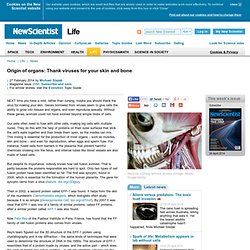
Genes borrowed from viruses seem to give cells the ability to grow into tissues and organs, and even reproduce sexually. Without these genes, animals could not have evolved beyond simple blobs of cells. Our cells often need to fuse with other cells, making big cells with multiple nuclei. They do this with the help of proteins on their outer surfaces that stick the cell's walls together and then break them open, so the insides can mix. This mixing is essential for the production of most organs – such as muscles, skin and bone – and even for reproduction, when eggs and sperm fuse. But despite its importance, nobody knows how cell fusion evolved. You Are What You Host: Microbiome Modulation of the Aging Process. The Lung Microbiome. A New Frontier in Pulmonary Medicine: Introduction and Perspective. Richard J.
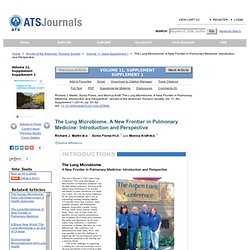
Martin, Sonia Flores, and Monica Kraft "The Lung Microbiome. A New Frontier in Pulmonary Medicine: Introduction and Perspective", Annals of the American Thoracic Society, Vol. 11, No. Supplement 1 (2014), pp. S1-S2. Richard J. The Human Microbiome. Early Life Determinant of Health Outcomes. Fernando D.

Martinez "The Human Microbiome. Early Life Determinant of Health Outcomes", Annals of the American Thoracic Society, Vol. 11, No. Supplement 1 (2014), pp. S7-S12. The Gut Microbiome and the Hygiene Hypothesis of Allergic Disease. Impact of Pets and Siblings on Infant Gut Microbiota. Meghan B. Azad, Theodore Konya, Heather Maughan, David S. Guttman, Malcolm R. GPR109a: The Missing Link between Microbiome and Good Health? The foliar microbiome. Astronaut gut reaction: The microbiome in space - health - 16 January 2014. GOING to space changes a person. But humans aren't the only space travellers we need to consider: microbes can change after just a few days without gravity.
Now scientists worry that the bugs astronauts bring with them in their guts may turn traitor in space. The human body isn't just one organism, but an entire community teeming with millions of microbes, so there's a whole community of new questions that spacefarers need to think about. In a report released last week, scientists at the US National Academies highlighted the extent of our ignorance about the way microbes behave in space, and how best to treat astronauts who get sick. The report cited studies showing that Salmonella typhimurium, known for causing food-borne illness, can change its genome to become more virulent after just a few days in space. Ancient hunter-gatherers had rotten teeth - life - 06 January 2014.
Ancient hunter-gatherers may have sustained themselves by eating lots of nuts and other starchy foods, but they paid a high price: rotten teeth. Scientists have long thought that tooth decay only became common in humans about 10,000 years ago, when we began farming – and eating starchy crops that fed sugar-loving bacteria on our teeth.
But Isabelle De Groote of the Natural History Museum in London, UK, and her colleagues have found widespread tooth decay in hunter-gatherers that lived several thousand years before the origin of agriculture. Her team analysed the remains of 52 adults who lived between 15,000 and 13,700 years ago, and who were buried together in a cave in Taforalt, Morocco. They found evidence of decay in more than half of the surviving teeth, a prevalence of dental disease comparable to that of modern, industrial societies with diets high in refined sugars. Only three skeletons at the site showed no signs of cavities. Paleo Dieters Beware — Cavemen Had Cavities Too.
From a site in Morocco and dated to more than 14,000 years old, these teeth are riddled with cavities and other signs of oral disease. That’s what you get for not flossing. Image courtesy of Isabelle De Groote. Had they existed, we’re betting four out of five Pleistocene dentists would have recommended chewing fewer nuts and acorns. A new study finds that prehistoric humans had as many cavities as modern people.
Pre-Agricultural People Had Cavities Too: Scientific American Podcast. The warm, moist environment of your mouth makes it a great place for bacteria—some of which keep busy causing cavities. Such dental difficulties were thought to have really taken off when we switched from hunting-gathering to agriculture and had a ready supply of farmed, fermentable carbohydrates. Now research shows that at least some pre-agricultural humans also had a bad case of tooth decay. The study is in the Proceedings of the National Academy of Sciences. [Louise T. Humphrey et al., Earliest evidence for caries and exploitation of starchy plant foods in Pleistocene hunter–gatherers from Morocco]
Beyond the microbiome: Mother lode: Superhero sugars in breast milk make the newborn gut safe for beneficial bacteria - Shugart - 2014 - Science News. Beyond the microbiome: The vast virome: Scientists are just beginning to get a handle on the many roles of viruses in the human ecosystem - Saey - 2014 - Science News. Beyond the microbiome: Microscopic. Menagerie: New view of microbes forces rethinking of what it means to be an organism - Milius - 2014 - Science News. Microbiome: B. fragilis and the brain.
The bacteria in breast milk. Bacteria are found in large numbers all over the human body where there is a channel to the outside world, for example in the gut, lungs, and surface of the skin. I’ve always thought that actually inside the human body was a bacteria-free environment unless an infection was raging so I was very excited to find that bacteria are present in breast milk. As a product which is made within the human body, breast milk was traditionally thought to be sterile. Several recent studies have found that breast milk contains a healthy dose of commensal bacteria; all the staphylococci, streptococci, and lactic acid bacteria that are found in the infant gut.
Can Microbes Clean Up Our Oily Mess? [Video] The Gut’s Microbiome Changes Rapidly with Diet. You are what you eat, and so are the bacteria that live in your gut. Microbiologists have known for some time that different diets create different gut flora, but previous research has focused on mice instead of humans, leaving the actual relationship between our food and our stomach bacteria unclear. Fresh air and sunshine: The forgotten antibiotics - health - 16 December 2013. Light, airy hospital rooms don't just have psychological benefits (Image: Plainpicture/Arturimages/Werner Huthmacher) IT WAS a warm summer's night in 1968, at the height of the cold war.
The evolution of resistance against good and bad infections - Gandon - 2013 - Journal of Evolutionary Biology. The OMICs: Applications in Neuroscience. The Pre- and Early Postnatal Microbiome: Relevance to Subsequent Health and Disease. Josef Neu, MD* + Author Affiliations Abbreviations: AF; amniotic fluid CD; cesarean delivery GA; gestational age IL; interleukin LOS; late-onset sepsis NEC; necrotizing enterocolitis SPF; specific-pathogen–free.
When Harmless Bacteria Go Bad. Babies' Weak Immune Systems Let In "Good" Bacteria. Do These Microbes Make Me Look Fat?: Scientific American Podcast. Our bodies are home to trillions of other organisms that influence our health—and probably our weight. Researchers found that mice given gut microbes from obese humans became fatter than those that got microbes carried by slim folks. Des terres rares essentielles à certaines bactéries. Pour en savoir plus. Pourquoi les nouveaux-nés résistent moins bien aux infections. Pour en savoir plus L'auteur. Gut bacteria may help combat cancer - health - 21 November 2013. First fungal farmers found harvesting bacteria - life - 30 October 2013. It's a mould breaker. Researchers have discovered the first fungus that behaves like a farmer.
We already know that soil fungi can help bacteria travel quickly from A to B. Different Ethnicities Have Distinct Mouth Microbes. Microbiome of free-living amoebae isolated from drinking water. Gas and the Microbiome. The Microbiome and the Brain-Gut Axis: A Role for Prebiotics and Probiotics. Gut Bacteria May Exacerbate Depression. Modulating the human gut microbiome as an emerging therapeutic pa. The root microbiome influences scales from molecules to ecosystems: The unseen majority1. Des bactéries pour combattre l'obésité ? Obésité : le risque de complication dépend de la flore intestinale. The root microbiome influences scales from molecules to ecosystems: The unseen majority1. Ecology, Diversity, and Evolution of Magnetotactic Bacteria. "The Influence of Diet on the Mammalian Gut Microbiome" by Brian David Muegge. Cancer: a missing link in ecosystem functioning?
PSYCHOSOMA – Guérir des maladies mentales en soignant l’intestin, ce « deuxième cerveau » ? Bacteria Found in Mouth May Cause Colon Cancer. Inside the root microbiome: Bacterial root endophytes and plant growth promotion. Wilson_Cotter_2013_Advances_C003_9780124071865.pdf. 'Parasitism is the most popular lifestyle on Earth' - opinion - 29 July 2013. The End of Antibiotics? - Body Horrors. Antibiotics Are More Mysterious Than They Appear. Characterisation of the human oral microbiome. Genomes of Giant Viruses Hint at "4th Domain" of Life. Gut bacteria vital in evolution of new animal species - life - 19 July 2013. Archives of Hellenic Medicine. Des chercheurs français découvrent deux nouveaux virus géants. Single-Cell Sequencing Reveals Genomes of More than 200 Unusual Microbes. The Vaginal Microbiome: New Findings Bring New Opportunities - Linhares - 2013 - Drug Development Research.
The Microbiome as a Therapeutic Target for Metabolic Diseases - Rajpal - 2013 - Drug Development Research. The Human Microbiome: Ethical, Legal and Social Concerns. The gut microbiome: The role of a virtual organ in the endocrinology of the host. The Quarterly Review of Biology, Vol. 88, No. 2 (June 2013), pp. 143-144. Microbiome in human health and disease. The plant microbiome.
The rhizosphere microbiome: significance of plant-beneficial, plant-pathogenic and human-pathogenic microorganisms - Mendes - FEMS Microbiology Reviews. Microbiome: With a little help from my phage friends : Nature Reviews Microbiology. Some Like It Hot, Some Not. Archaea and Fungi of the Human Gut Microbiome: Correlations with Diet and Bacterial Residents.
Untitled - GutInflam_RPNSE513_WM.pdf. The fractal patterns of bacterial colonies. Squatters of the microbial world: foram-in-a-foram. Energy, ecology and the distribution of microbial life. Cultivating Our “Frienemies”: Viewing Immunity as Microbiome Management. The role of the bacterial microbiome in lung disease, Expert Review of Respiratory Medicine, Expert Reviews. The effect of petting a dog on immune system function. : Seriously, Science? Behavioural Processes - Ingestion of Mycobacterium vaccae decreases anxiety-related behavior and improves learning in mice. Recycling Metchnikoff. Probiotics, the Intestinal Microbiome and the Quest for Long Life. Animal Production Science. Comment l'organisme cohabite avec sa flore intestinale. OMI. Host-Bacterial Mutualism in the Human Intestine.
Earth Microbiome Project. Combien avons-nous de bactéries dans le corps ? Fake Colon Spills Bacterial Secrets: Scientific American Podcast. Journal of Proteomics - Metaproteomics of our microbiome — Developing insight in function and activity in man and model systems. Current Opinion in Biotechnology - Towards a predictive systems-level model of the human microbiome: progress, challenges, and opportunities. Gut microbiota and obesity: lessons from the microbiome.